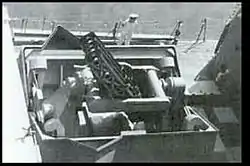Terne ASW
Terne is a Norwegian anti-submarine weapon system, which uses rocket-thrown depth charges. It was developed by the Norwegian Defence Research Establishment (FFI) in cooperation with the U.S. Navy in the late 1940s-early 1960s. The Terne development project consisted of three phases:
| Terne III Mk8 | |
|---|---|
 Terne III Mk.8 ASW system opening its clam gate | |
| Type | Anti-submarine weapon |
| Service history | |
| In service | 1964 |
| Production history | |
| Manufacturer | Kongsberg Defence & Aerospace and A/S Raufoss |
| Produced | 1950 (Terne I) |
| Specifications | |
| Mass | 135 kg |
| Length | 1.95 m |
| Diameter | 0.21 m |
| Warhead | 50 kg |
Detonation mechanism | Delay Fuse |
| Engine | Solid-fueled Rocket; 52 kN (11700 lb) |
| Wingspan | 0.24 m |
Operational range | 425-1600 m |
Guidance system | Unguided rocket + depth charge |
Launch platform | Land and Naval ships |
Terne I : Development of a rocketborn depth charge.
Terne II: Development and construction of a landbased ASW for naval defense.
Terne III: Development and construction of a shipborne ASW.
A Terne III weapon system consists of a search & track sonar, a fire-control system and the rocket launchers, which can store six salvos of six rockets each. The rocket itself, is a depth charge with multiple fusing modes (preset time after water entry, proximity, or contact), which is propelled through the air by a solid-fueled rocket motor. When the sonar detects a target, the fire-control system can fire a rocket salvo to place a string of depth charges 18 m (20 yd) apart, perpendicular to the target's course.
User countries
 United States (Phased out)
United States (Phased out) Germany (Phased out)
Germany (Phased out) Norway (Phased out)
Norway (Phased out)
